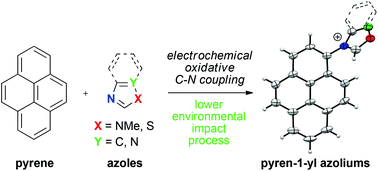Towards sustainable synthesis of pyren-1-yl azoliums via electrochemical oxidative C–N coupling†
Abstract
Electrosynthesis of 1-methyl-3-(pyren-1-yl)-1H-imidazol-3-ium tetrafluoroborate via oxidative C–N coupling of pyrene with methylimidazole is optimized with the aim to reduce waste and simplify the experimental setup. Several parameters are tested such as cell configuration (number of compartments), pyrene concentration, amount of nucleophile, electrosynthetic method (potentiostatic/galvanostatic), amount of electrons, atmosphere (Ar/air), solvent quality and presence/absence of a supporting electrolyte. The optimized conditions are successfully applied to the synthesis of 1-methyl-3-(pyren-1-yl)-1H-benzimidazol-3-ium tetrafluoroborate, 1-methyl-4-(pyren-1-yl)-1H-1,2,4-triazol-4-ium tetrafluoroborate and 3-(pyren-1-yl)-benzothiazol-3-ium tetrafluoroborate. These four pyren-1yl-azolium salts are characterized by NMR, MS, elemental analysis, UV-Vis absorption and emission spectroscopy. The X-ray crystallographic structures of 1-methyl-3-(pyren-1-yl)-1H-imidazol-3-ium tetrafluoroborate and 1-methyl-3-(pyren-1-yl)-1H-benzimidazol-3-ium tetrafluoroborate are presented.


 Please wait while we load your content...
Please wait while we load your content...